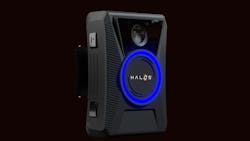Enhancing railway safety: The benefits of body-worn cameras in mass transit
Body-worn cameras are transforming safety and security practices across various industries — from retail to private security to healthcare—and the railway sector is no exception. This is, in part, driven by transit crime being a top concern in some U.S. cities like New York City and Philadelphia, where violence in busy transit settings has put pressure on government officials and legislators to take action. Increasing the presence of police and even the National Guard in the case of New York City has been a go-to strategy, but technology also has a role to play.
Transit crime is on the rise elsewhere globally, too. In the U.K., for example, the British Transport Police Authority reported in 2024 that the number of recorded violent crimes against females on the transport network had risen by 20 percent within a year.
Railway companies internationally are finding body-worn cameras to be useful in a variety of ways. Predominantly, they're being used to contribute to the safety and security of onboard staff and passengers, as well as frontline station personnel. This dual approach highlights the versatility of bodycams in addressing the diverse security needs within mass transit environments, and specifically, passenger rail.
The benefits highlighted here reflect actual feedback shared by a U.K.-based rail company using body-worn cameras during a focus group conversation.
Evidence collection and legal support
One of the most compelling advantages cited by the aforementioned rail company is their near-perfect success rate in court cases involving bodycam footage. Since deploying the cameras, the company has not lost a single case. The high-quality audio and video captured by the cameras provide irrefutable evidence, often leading to swift resolutions. In one instance, a magistrate halted proceedings mid-trial after viewing the footage, urging the defendant to reconsider their plea. This illustrates how powerful body-worn cameras can be in ensuring justice and deterring false claims.
Streamlining operations
Beyond legal proceedings, this technology helps streamline operational processes. The efficient MP4 format of the footage integrates seamlessly with existing redaction platforms, saving significant time and resources. According to the rail company that participated in the focus group, the cloud storage platform for the video files also enhances efficiency by providing a centralized repository for footage, making it simple to retrieve and share the files. The ability to create cases within the cloud platform and attach related documentation ensures a comprehensive record of each incident, all stored and organized in a single place.
Curbing passenger incivility
The presence of a body-worn camera enhances staff safety by decreasing the likelihood of undesirable passenger behaviors. noted a trial of bodycams in U.K. train stations with high assault rates against staff saw a 47 percent reduction in the odds of assaults against bodycam-equipped workers. The study, "Reducing Assaults Against Staff Using Body‑Worn Cameras in Railway Stations," was originally published in Criminal Justice Review in 2019. The trial program it highlights also discovered residual safety benefits: It found all workers were less subject to aggressive behavior, not just those outfitted with the cameras.
Embraced by staff
The staff of the aforementioned rail company said feedback has been overwhelmingly positive, particularly among security and revenue officers. The cameras are perceived as a valuable tool, enhancing employees' ability to perform their duties effectively. Users gave a nod to the ease of use of the technology and its user-friendly design, contributing to the bodycams' reliability and acceptance among staff. During the focus group, the rail company noted their plan to more heavily use some of the latest features such as a "man down" warning or panic button, demonstrating the company's desire to continue finding ways to use the camera to enhance staff safety.
Notably, features like the built-in panic alert that enables employees to discreetly call for assistance are highly regarded by companies deploying bodycams, as they reassure staff that they have back-up support if necessary. That's especially important for employees in a lone-worker environment or those isolated on a railcar, for example, where co-workers aren't within view of one another. The ability to live-stream encounters also help reassure rail employees they aren't alone, knowing other team members have an uninterrupted view of their whereabouts.
Adoption of body-worn cameras by railway companies is growing globally and for good reason. The technology offers a multitude of benefits, from enhanced legal outcomes and operational efficiency, to improved staff safety and security. As bodycams become increasingly sophisticated in features and functionality, they will play an important role in ensuring a secure and efficient railway environment for staff and passengers alike.
About the Author

Alan Ring
CEO of HALOS
Alan Ring is the CEO of HALOS and a dynamic leader with 15-plus years of experience in financial services, healthcare and engineering. Renowned for his ability to identify opportunities, optimize resources and foster high-performing teams, Ring has consistently delivered transformative results for small and mid-sized companies.
